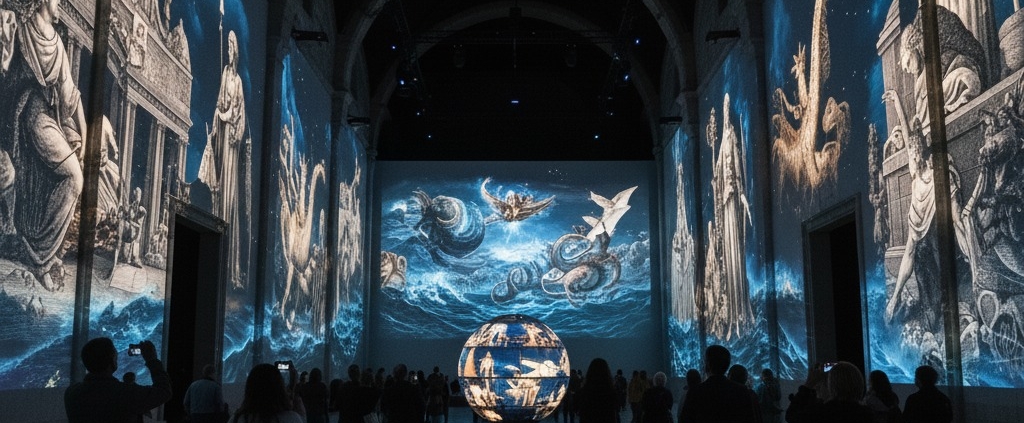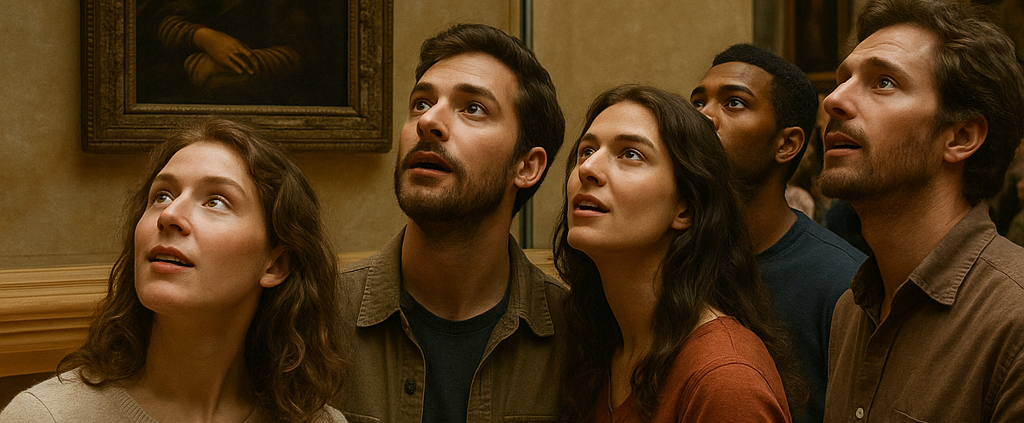1. Introduction
In the UK, “immersive exhibition” has become shorthand for large-scale projection environments, spatialised sound and sensorial scenography—often blended with XR—to create the feeling of stepping into anzother time and place. The “immersive” label is also a marketing lever that widens the funnel to families and first-time museum-goers while recasting art and heritage as experiences. London now concentrates several flagship venues. Frameless, a permanent multi-gallery site by Marble Arch, bills itself as the UK’s largest permanent multi-sensory experience. Lightroom in King’s Cross launched in 2023 with “David Hockney: Bigger & Closer,” quickly establishing a new model for artist-led immersive shows. Outernet London, wrapped around Tottenham Court Road tube, uses vast 16K LED surfaces to deliver free, walk-in spectacles and reports weekly footfall in the millions across its district. Together they show how the UK has fused blockbuster entertainment with cultural signifiers in a way that is both public-facing and commercially sophisticated.
2. Genesis and historical context
The British story of immersion long predates lasers and media servers. In 1787, Irish-born painter Robert Barker coined and patented the term “panorama,” ultimately erecting a purpose-built rotunda at Leicester Square where audiences stood on a central platform beneath a skylight to view 360-degree cityscapes—an early template for total visual environments. The panorama craze of the late eighteenth and nineteenth centuries foreshadowed today’s wrap-around image worlds and the choreography of audience movement through space.
The UK’s contemporary resurgence extends that lineage through projection mapping, spatial audio and XR, but also through permanent, regionally distributed infrastructure such as The Reel Store in Coventry—opened in 2022 as the UK’s first permanent digital art gallery in the wake of “UK City of Culture”—which shows how immersive spaces can anchor post-industrial regeneration strategies beyond London.
3. Emblematic actors and case studies in the UK
A. London’s flagship triangle: Frameless – Lightroom – Outernet
London’s triangle of Frameless – Lightroom – Outernet captures the breadth of the market. Frameless positions itself as a “gallery of immersive masterpieces,” with four rooms and a tightly engineered media and audio stack; the venue and partners consistently situate it as the country’s largest permanent, multi-sensory art experience. Lightroom operates more like a production stage for artist-centred narratives: the Hockney launch set the tone for a 50-minute looped show and, within its first month, drew average daily audiences well above two thousand, demonstrating appetite for premium, single-artist immersives. Outernet reframes immersion as civic spectacle: its Now Building and public atria have claimed daily district footfall over 220,000 and more than six million visitors in the Now Building across its first year—figures that place it among the UK’s most visited attractions, with the added advantage of being free at point of use.
B. Beyond the capital: Coventry’s The Reel Store
Beyond the capital, The Reel Store demonstrates a regional model: a permanent projection gallery born from the Coventry City of Culture programme, it mixes touring installations and new commissions to maintain a rhythm of audience return and to embed immersive practice in local cultural economies. The venue’s positioning as the UK’s first permanent digital art gallery underscores how a national network of sites can complement London’s gravitational pull.
4. Why the UK market grew—and what sustains it
Public R&D has been unusually well aligned with market formation. UKRI’s Audience of the Future challenge (2018–2022) invested £39.3 million to prototype technologies and production methods for immersive experiences and to study audiences across culture and entertainment. In parallel, the AHRC Creative Industries Clusters Programme (2018–2023) channelled roughly £56–61 million into university–industry consortia, seeding pipelines for talent, tools and IP that now flow into commercial immersive venues. Industry bodies such as Immerse UK and Digital Catapult have provided data on company counts, exports and growth, plus playbooks on production and distribution—helping move the sector from one-off spectacles to repeatable, scalable products. The UK government’s broader Creative Industries Sector Vision (2023) adds a spine of capital and policy intent, signalling continued commitment to creative-tech spillovers including location-based experiences.
5. Critiques, impacts and future directions
The promise of democratisation is partly borne out: Frameless and Lightroom have drawn inter-generational audiences, while Outernet’s free public galleries reduce the price barrier and pull in huge pass-through crowds at a major transport hub. Yet critics repeatedly question whether immersive shows replace, rather than complement, encounters with original works; the debate around Lightroom’s Hockney programme typified concerns over spectacle versus substance.
Economics also intrude. Premium ticketing and reliance on “bankable” IP can drive high occupancy but may compress curatorial risk, while the closure of BBC Earth Experience in London after less than a year—despite strong brand recognition—shows the volatility of temporary attractions and the need for careful unit economics; the production subsequently redeployed to Melbourne, underlining how these formats migrate as international franchises. The sector’s counter-move is more hybrid authorship: research-backed narratives, VR-guided segments, and data-rich audience analytics to balance wow-factor with learning value and long-term engagement.
6. Conclusion
The UK’s immersive exhibition scene has matured quickly by coupling permanent venues and agile producers with targeted public R&D and a lively private market. London acts as the global shopfront, while Coventry and other cities show that regional anchoring is possible and desirable. The durable path forward is not to oppose spectacle and knowledge, but to yoke the sensorial power of immersive environments to robust curation, clear learning outcomes and accessible pricing. If that equilibrium holds, the UK can consolidate its lead as a place where immersive culture doesn’t just entertain for an hour, but deepens understanding and expands the appetite for art and heritage.



